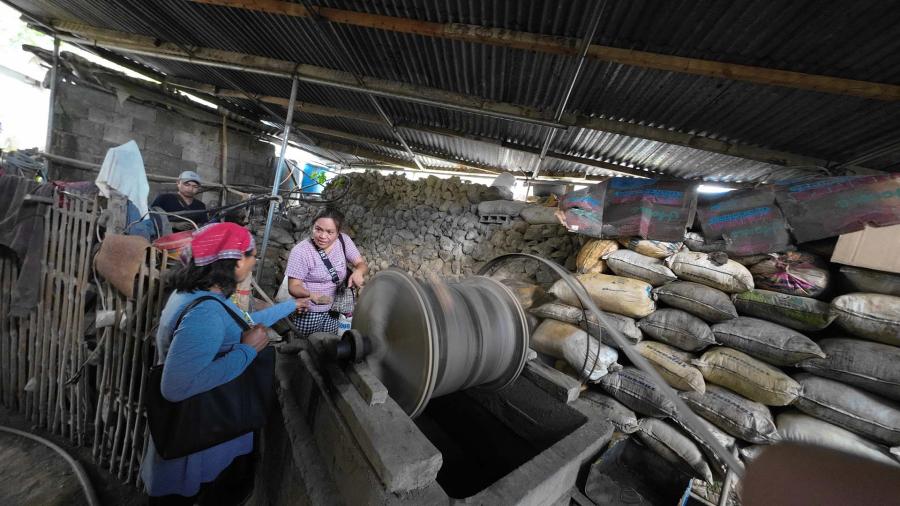The tourists who flock to Nepal in ever-increasing numbers are offered an idyllic vision of rural life, seemingly unchanged for centuries, set among some of the most spectacular mountain scenery in the world. Yet this image is illusory; despite revenue from tourism and massive injections of foreign aid (now totaling over half the national budget), the rural population in the Hills of Nepal is caught in a cycle of impoverishment. Their only resource, the land, is literally slipping away from them.
The Hills comprise the broad band of mountainous land, between 600m and 3,000m in altitude, which lies between the high snow-capped Himalayas to the north and the Ganges plain to the south. The traditional mixed farming system in this area involves a delicate and crucial balance in the use of arable and forest land. The fertile valley bottoms and the steep hill slopes are intensively cultivated by constructing terraces, often with complex irrigation systems. Above the arable land the natural forest has always provided a wealth of products and benefits. As well as fuelwood and construction timber, villagers collect leaf fodder for dry season animal feed, litter for animal bedding and subsequently (mixed with manure) for compost, and many other important products including fruit, mushrooms and medicinal herbs. The forest also provides grazing land for livestock. Equally essential is its role in soil and water conservation. Tree roots bind the soil of the steep upper slopes and at the same time reduce run-off from heavy monsoon downpours; this has the dual benefit of stabilizing the slopes and improving water supply from springs and wells.
The stability and fertility of the agricultural land thus depend absolutely on the maintenance of a healthy forest. It has been estimated that a forest area three times the arable area may be necessary for the maintenance of the agricultural system as a whole. Yet over the last decades the forest area has declined dramatically, and the trend is continuing. The problem of deforestation in Nepal is not one of exploitation by outsiders; there are almost no roads in the Hills, and logging on a commercial scale would not be feasible. The problem stems rather from the acute and increasing pressure on the land. The Hill population is now estimated at 1,500 people per square kilometer of cultivable land, with livestock numbers comparable to the human population.
Throughout the Hill districts of Nepal the cycle of environmental degradation is frighteningly clear. Land that once supported healthy regenerating forest is now covered with scrubby, largely unpalatable bush vegetation in which continuous overgrazing and lopping for fodder has prevented any regeneration and gradually removed the valuable edible species. Women have to walk farther and farther to collect fuel and fodder for the family's needs; in many parts of the district the round trip takes a full day. In local markets and centers of population a backload of wood may sell for the equivalent of two days' wages.
As the productivity of the forest declines through relentless overcutting, its ability to provide nutrients to the arable fields, through fodder and leaf litter, is also reduced, and crop yields start to fall. This, combined with direct population pressure, pushes cultivation on to steep and marginal land, greatly increasing the risk of landslides and soil erosion. In Doti, a district typical of the remote far west of the country, monsoon floods in 1983 did unprecedented and permanent damage to the land. Old farmers remembered similar rains, but the recent imbalance between forest and cultivated land makes the effects this time far more severe. Every year the story repeats itself somewhere in the Hills.
Elsewhere in the country, other new pressures are making themselves felt. Tourism is Nepal's biggest growth industry, and every year thousands of foreign visitors take the well-known trekking routes - to Everest Base Camp, to Langtang, or the circuit of the Annapurnas. The pressure of this influx on both the local culture and the environment is extreme. The sudden monetization of a previously subsistence economy brings with it disruption and change in both the society itself and the relationship with the land; traditional systems break down as young people find work instead with the tourists, as porters or guides. At the same time the trekkers provide an insatiable market for fuelwood, and deforestation in the tourist areas is even more severe than elsewhere. The problem is exacerbated by the routes tending, by definition, to go to high altitudes where not only is tree growth very slow, but wood is needed for heating as well as cooking. In Sagarmatha National Park, on the route to Everest, an attempt has been made to control this growing problem by strictly prohibiting the cutting of wood and requiring trekking groups to bring kerosene fuel with them, but despite these measures the problem remains acute.
In the late 1970s the government of Nepal recognized that deforestation throughout the Hills could only be tackled by enlisting the active support and cooperation of local people. New land tenure laws were introduced by which forest land, which had been nationalized in the late 1950s, could be returned to ownership and management by the local community in the form of the panchayat - a local administrative unit comprising several villages, usually with a total population of about 5,000. Within this framework, "community forestry" activities were initiated throughout the country, funded by a variety of aid donors. Such projects aim to establish new plantations on panchayat-owned land, to distribute seedlings to farmers for planting on private land and to bring existing but degraded forest under more sustainable management. So far the most popular and successful of these activities has generally been private planting, because people are confident in this case that they will reap the benefits of their work. There is also a tradition of planting trees, particularly for fruit and fodder, on private land, whereas forest products from public land have traditionally been regarded as a "free good" in which no investment is necessary.
If deforestation is to be reversed, or even slowed, this attitude will have to change. Any attempt at reforestation on the massive scale that is required will only succeed if there is commitment among local communities to invest their own time and labor in planting and protection of trees on community-owned land; and this will happen only if they believe that the benefits to them will be worth this investment. Management of common property resources is a complex business, and unlikely to succeed if imposed from outside; but to have any significant effect on the agricultural system as a whole there will have to be much more planting on public land than could be achieved by any project working in isolation. Communities will have to develop all sorts of rules governing protection, permissible livestock numbers, distribution of benefits and so on. In the past there have been many cases in Nepal of traditional management of existing communal forest, but many of these systems collapsed following the nationalization of all forest land in 1957. Rebuilding of the necessary institutions at the village level will inevitably be a slow process, but in the long term it is the only path by which Nepal's forests can be saved from further destruction.
Article copyright Cultural Survival, Inc.



